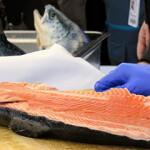Genetically modified salmon producer AquaBounty advances to product commercialization
AquaBounty, the controversial U.S. firm that has figured out how to make Atlantic salmon grow faster through genetic engineering, continues its march toward widespread distribution of its salmon.
On 12 January, it issued an underwritten public offering that is expected to raise USD 12 million (EUR 9.9 million). The company said the new funding will help it build and operate more production facilities in the United States.
The company’s story is unique in the seafood industry, many parts of which still do not accept AquaBounty as one of its own. Its history dates back to 1989, when it first developed its genetically modified salmon. Within a few years was seeking regulatory approval from the U.S. Food and Drug Administration to sell it, but that process dragged on for 20 years starting in 1995, when the FDA started its review.
But in 2015, the agency granted approval for AquAdvantage Salmon. It was the first time the FDA had approved a genetically modified animal for human consumption. Health Canada approved the sale of the salmon shortly after, in 2016.
Now, AquaBounty is poised to commercialize its product and expand its market share.
“We’ve come through the R&D phase, we’ve been through the approval phase, and now we’re going to commercialization,” Dave Conley, AquaBounty’s spokesman, told SeafoodSource. “It’s been a long journey from 1989 to today, probably longer than anybody anticipated.”
A limited number of salmon have been sold in Canada, produced at the company’s small Panama-based grow-out research facility, which can only produce 30 metric tons of fish per year.
Large-scale production is slated to ramp up once AquaBounty finishes renovating an aquaculture facility it acquired in Indiana in June 2017 for USD 14.2 million (EUR 11.8 million) from the previous owner, Bell Fish Company, who acquired the facility out of bankruptcy. That facility will produce 1,200 metric tons (MT) of salmon per year.
AquaBounty has another, smaller facility in the works on Prince Edward Island in Canada that will produce 250 MT per year. Both facilities are planned to come online in May or June of 2018.
AquaBounty’s land-based recirculating aquaculture systems ensure the genetically modified fish cannot escape and interbreed with wild salmon populations. During the 1990s, AquaBounty recognized the danger of fish escapes and chose to pursue only land-based systems.
“There are no wild Atlantic salmon populations in Indiana. It’s in the middle of a farm field, so the concerns about escape are moot,” Conley said.
The Albany, Indiana location will also enable AquaBounty to drastically reduce the carbon footprint of transporting the salmon to market; the facility is just a few hours away from Indianapolis, Chicago, Cincinnati, Columbus, Detroit, and other major cities.
But so far, AquaBounty can only sell fish in Canada because U.S. regulators are still sorting out product labeling rules.
Legislation passed by Congress in July 2016 called the National Bioengineered Food Disclosure Standard, or Labeling Act, set a national standard for labeling retail products that contain genetically modified organisms. The U.S. Department of Agriculture is supposed to implement the law by July 2018.
At the same time, another bill, introduced in the U.S. Senate in July 2017 could require labeling specifically for AquaBounty salmon. That legislation, if passed, could also require the FDA to reexamine the approval it granted to AquaBounty in 2015.
Additional labeling rules could hurt sales, according to AquaBounty.
“Labeling requirements could cause consumers to view the label as either a warning or as an indication that AquAdvantage Salmon is inferior to traditional Atlantic salmon, which could negatively impact consumer acceptance of our product,” AquaBounty wrote in a November quarterly report for investors.
Canadian regulators, in contrast, chose not to impose any labeling requirement, reasoning that AquaBounty salmon is equivalent to normal Atlantic salmon and poses no food safety or allergy concerns. The fish is identified on store shelves simply as “farmed Atlantic salmon.”
“From a health and safety standpoint, they are just as safe to eat,” Conley said. “The only difference between our salmon and other salmon is that it grows faster, it gets to market faster. It’s more feed-efficient.”
Similar efficiency results could have been obtained through conventional breeding, but genetic modification is both quicker and much more precise, Conley said. Conventional breeding might be able to double the growth rate of salmon in six generations, over a minimum of 24 years; AquaBounty did it in one generation over a period of two .
“The gene gives you the exact trait you want,” Conley said. Conventional breeding selects for a muddle of genes. The fish “could be more susceptible to disease. There are other things that could be in there. That’s why we call it precision breeding. You have a gene, it gives you a trait.”
Since AquaBounty started seeking approval for its genetically-modified fish, gene editing methods have improved and molecular biology has advanced. Today, new research is coming out of the academic world and the private sector that is leading to new crops and new animal livestock.
Competitors are likely to be on AquaBounty’s heels: the patent for AquAdvantage Salmon expired in 2013. But any other companies would still have to go through the FDA approval process, Conley said.
“Most of the barrier to entry is the cost because you’ll have to start from scratch,” Conley said. “We’ve been growing these fish since 1989. We’re pretty good at it. We think we can produce these salmon competitively, and we can bring them to market.”






Share